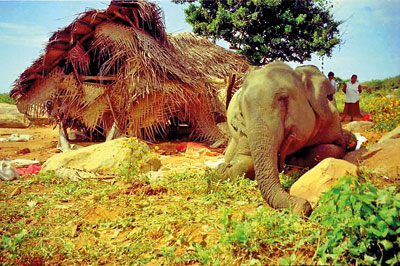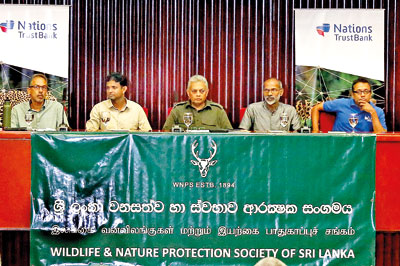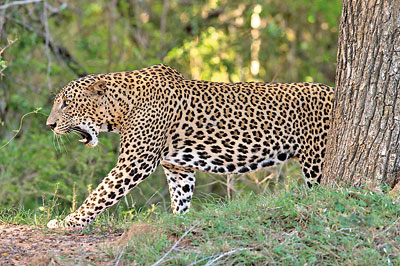News
Is human-elephant conflict ‘mitigation’ whacking elephants?
The cake came last for it was celebration time for an organisation considered one of the oldest in the conservation arena in Sri Lanka and the third oldest in the world.

A stark image of the human-elephant conflict. Pic courtesy CCR
As Wildlife and Nature Protection Society (WNPS) President Sriyan de Silva Wijeyeratne sang happy birthday and everyone else joined in lustily, it was Immediate Past President Rukshan Jayewardene who cut the yummy cake on Wednesday.
For, it was the society’s 125th birthday and it was not just a celebration but also ensuring a further commitment towards conservation, made with a strong underlying sense of responsibility. Before the cake-cutting, the 125th anniversary commemorative issue of ‘Loris’ – the English-language publication of the WNPS which was first published back in November 1936 – was also launched.
What of the future? How should Sri Lanka balance development and conservation?
These were the critical topics that generated much discussion after a distinguished four-member panel of conservationists moderated by outspoken Dr. Sumith Pilapitiya, a former Director-General of the Department of Wildlife Conservation (DWC) and conservationist in his own right, looked closely at – ‘Where is Wildlife Conservation in Sri Lanka Today?’
There was doom and gloom but also slivers and glimmers of hope.
In the 24 hours preceding the event, another tusker had been shot and as reiterated by Dr. Pilapitiya Sri Lanka is at the crossroads – wildlife conservation is by default than design.

The panel (from the left): leopard researcher Rukshan Jayewardene, Dr. Sampath Seneviratne, moderator Dr. Sumith Pilapitiya, Dr. Prithiviraj Fernando and marine biologist Nishan Perera. Pic by M.A. Pushpa Kumara
“Animal populations have declined drastically. Wild animal populations are decreasing while tourist numbers are increasing,” said Dr. Pilapitiya, pointing out that there is not just a Human Elephant Conflict (HEC) but also a Human Wildlife Conflict, along with a steady increase in political interference in conservation efforts. This was “depressing”.
However, the glimmer of hope was that the DWC has started developing many plans in-house. It is also working in tandem with the Sri Lanka Tourism Development Authority (SLTDA) and other stakeholders.
The DWC is training and certifying jeep drivers in National Parks (NPs). In Minneriya and Kaudulla there are over 700 such drivers, while two-thirds of the drivers in the Wilpattu NP are also trained. Next will be Uda Walawe and finally Yala.
The panel on Wednesday focused on two roaming terra firma – elephants (Dr. Prithiviraj Fernando) and leopards (Rukshan Jayewardene) – one in the air, birds (Dr. Sampath Seneviratne), and the turquoise blue seas to take a look at the coral reefs (marine biologist Nishan Perera).
Pointing out that due to the HEC both humans and elephants suffer, Dr. Prithiviraj Fernando, an extensive elephant researcher and Chairman of the Centre for Conservation & Research (CCR), highlighted some important facts.
According to an island-wide survey done recently:
n There are elephants in 62% (40,625km2) and people in 82% of the land area of Sri Lanka.
n There are no people in 18% of the land area.
n There are no elephants in 38% of the land area.
n Humans and elephants live together in 44% (28,600km2) of Sri Lanka’s landscape.
Stressing that elephants suffer in many ways due to the HEC and showing heart-rending images, he said that they are killed and injured by snares and hakka patas (jaw bombs), they are shot and electrocuted and they fall into agricultural wells and pits and die. Every year, around 250 elephants are killed in the country and last year such deaths exceeded 300.
On the other hand, said Dr. Fernando, farmers suffer crop losses due to elephants, while elephants break down homes to get to stored harvests, in the process injuring or killing people. Every year, about 70 people die in the country due to the HEC.
“Though both people and elephants become victims of the HEC, it is perceived only as a people’s problem, as HEC mitigation only addresses people’s issues and most of the mitigation measures are harmful to elephants,” he said.
The main responsibility of the agency tasked with the mitigation of the HEC, the Department of Wildlife Conservation, should be the conservation and welfare of wild animals. Instead, it is compelled to look after people, for which there are numerous other state institutions – which play little part in addressing this ‘people’s problem’, he pointed out.
According to Dr. Fernando following a ‘master plan’ developed in the 1940s, the wildlife authorities have tried to solve the HEC by putting all the elephants into Protected Areas (PAs). The fact is that our PAs have all the elephants they can support. Currently over 70% of elephants are outside PAs. Trying to stuff all of them into PAs is like trying to add a bottle of water into a glass already full of water.
Looking at the so-called mitigation methods that have been tried for more than 70 years, he lists them as: translocation of males which is creating problems in human-inhabited areas; elephant drives to get elephants into PAs; electric fences around PAs; and distribution of elephant thunders (very big firecrackers) to farmers to protect their crops.
Dr. Fernando said: “Yet all these ‘mitigation’ methods only aim to benefit people, not elephants. Translocations ‘kidnap’ elephants and dump them at a far away location completely alien to them. Elephant drives, chasing elephants and using elephant thunders cause immense harassment, as a result of which they live in fear and don’t come out of the forests during the day. They have to suffer thirst and hide in the forest all day, waiting till dusk to have a sip of water.
“Elephants driven out of their home ranges and fenced into parks starve to death. Removing elephants from their home ranges causes loss of habitat and range which could lead to local extinction. Many of these mitigation methods also increase the HEC by making elephants more aggressive towards humans.”
So, what would be the answers to the HEC, asks this scientist, giving the possible options – get rid of the 10-15 million people living in areas occupied by elephants; get rid of the 4,000-5,000 elephants living in areas occupied by people or live together as they have been doing for thousands of years, but manage the conflict to minimise negative impacts on people and elephants: human-elephant co-existence.
Clearly getting rid of people cannot even be considered. We have tried very hard to get rid of the elephants for 70 years but failed miserably and ended up with a high level of HEC as a result. So there is no option other than co-existence, he says, stressing that co-existence with elephants does not mean having an elephant in your backyard. It means separation of elephants and people at a fine scale, within the same landscape.
It has been tried and tested in Sri Lanka, and found to be effective in mitigating the HEC. Some African and Asian countries are already learning from Sri Lanka and wanting to follow this model, it is learnt.
The co-existence model, says Dr. Fernando, is based on creating awareness among stakeholders to take responsibility for their actions. It means permanent electric fences to protect villages and seasonal electric fences to protect crop fields until the harvest is gathered, in areas where both elephants and people live.
However, only communities who face the HEC, assisted by the agencies responsible for their welfare and development – particularly the District Secretariats and the agricultural sector – can implement the co-existence model at a relevant scale. The conservation sector can show the way but they cannot solve the HEC, he adds.
(Next the birds & reefs)
| The threats to our big cat – the leopard The world’s most widely-distributed large carnivore, the leopard, a genetically-distinct sub-species of which lives in Sri Lanka, was the focus of Rukshan Jayewardene who turned the spotlight on the threats faced by Panthera pardus kotiya in the Dry and Wet Zones of Sri Lanka including mountain landscapes. Taking a walk into the past, Mr. Jayewardene who has studied these sleek and fascinating felines and co-authored a book on them said that this wild cat is highly evolved and may have been the first large cats that preyed on early humans. “Thus, humans and pre-humans and leopards have a long history…..where we live, they can live too. That could probably be one of the reasons why leopards have a good understanding of humans, but with nearly 3 million years of association humans have learned very little of the leopards.”  The Sri Lankan leopard Pic by Rukshan Jayewardene Explaining that early studies done by Dr. Sriyanie Miththapala have found that the Sri Lankan leopard is distinct from India’s Panthera pardus fusca, he stressed that if it disappears, the world will lose one of its 14 leopard sub-species. Getting down to ground level, Mr. Jayewardene said that in the Dry Zone when the leopards lose their natural habitats, they may prey on cattle, buffaloes and goats. The herders will tolerate this to a point but after a while will poison the carcasses, in turn, killing the leopards. Under mitigation action against this threat, he explained that chain-link cages were distributed to cattle-keepers so that they could keep young calves, the common prey leopards picked on, in them at night. “This has been successful most of the time but occasionally leopards have ripped open the cages and gotten in as they are by nature very resourceful, tenacious and don’t give up easily.” In the tea lands of the Wet Zone, according to Mr. Jayewardene, wire snares are used to kill leopards. Leopard skin and meat prepared for consumption can be seen in Sri Lanka which could be linked up to the international trading of body parts. He pointed out that sometimes people would set snares in forests and that unfortunately the very small percentage of black leopards found in the country were also possible targets. Lamenting that ‘leopard fever’ is exerting much pressure on these creatures within the Wilpattu and Yala National Parks, he stressed that there is a need to manage leopard-centric tourism as more than any other animal, people are drawn to them. “In leopard conservation in Sri Lanka, there is a severe lack of law enforcement,” said Mr. Jayewardene, adding that the biggest obstacle comes from political interference.
| |

